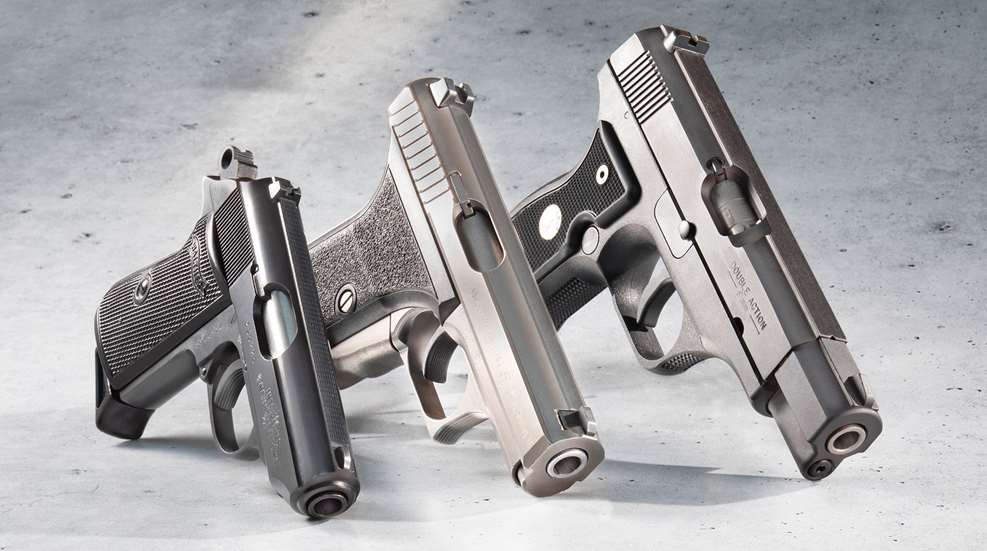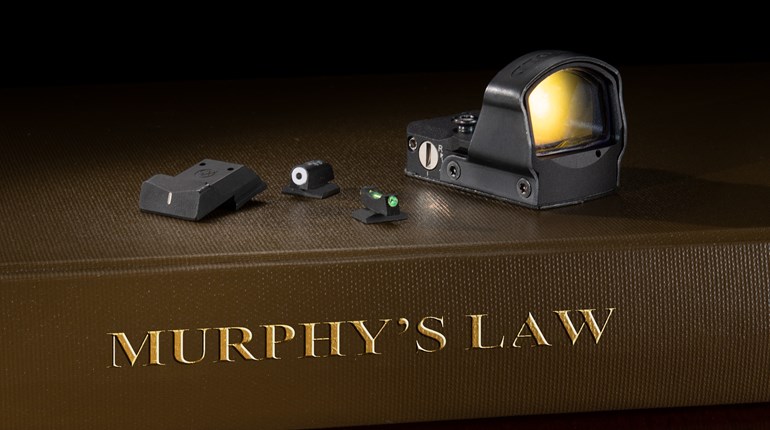
Unusual actions occasionally seen in carry guns include (left to right) blowback (Walther PPK), delayed blowback (H&K P7) and rotary (Colt All-American 2000).
There’s a large slice of the shooting demographic that just loves something a little novel, a little different. Internet phenomenon Ian McCollum has basically made a career out of catering to this interest in the unusual with his blog and Forgotten Weapons video channels.
If you really want to perk up the attention of these folks, a firearm that’s a little off the beaten path is a sure-fire way to do it. Whether it’s revolvers that fire from the bottom chamber or work with shotgun shells, pistols that fold, or derringers with an unusually large number of barrels, you’ll find enthusiasts for it. Unusual operating systems are also a guaranteed crowd pleaser here.
Take the humble blowback-operated pistol. This is the simplest operating mechanism for a semi-automatic pistol. Basically, the barrel is fixed to the frame and doesn’t move, and the breech is held closed long enough for the bullet to exit the barrel by naught but the mass and inertia of the breechblock and the strength of the recoil spring.
Incidentally, this is the entire reason Browning invented and patented the pistol slide: It’s a way to add mass and weight to the breechblock by essentially extending it forward and wrapping it around the barrel. Colt’s possession of that patent is why all the early semi-auto pistols from other American manufacturers had separate breechblocks.
Anyway, blowback operation is most suited to smaller, less-powerful cartridges. If you want to use it with anything much more powerful than a .380 ACP, you either need to fit a recoil spring more suited to the suspension of a Buick station wagon with the towing package, or else you have to add so much mass to the slide that you wind up with—well, have you looked at how much heavier a Hi-Point 9 mm is than other 9 mm pistols of similar dimensions? That’s blowback for you.
Enter delayed blowback!
The most common method of retarding the rearward motion of the slide is putting a small gas port in the barrel not too far forward of the chamber. As the projectile passes this port, propellant gasses will be bled into a cylinder in the frame and press forward against a piston that’s attached to the slide, holding the slide closed until the projectile exits the barrel and lets pressures equalize.
This was most famously done in the P7 series of pistols by Heckler & Koch (which also had a novel squeeze-cocking mechanism), but shooters today who can’t afford an expensive and long discontinued H&K can still get some of that classic gas-delayed action with the Walther CCP M2.
While this novel setup allows for a system that basically self-regulates for higher- or lower-pressure cartridges—essentially adding extra braking force to the slide with higher-pressure +P loads—it also pipes hot propellant gasses into the frame just above the trigger guard. This soon renders pistols in the series too hot to handle, despite the addition by H&K of a heat shield. If this type of delayed-blowback just seems too pedestrian, one could always seek out a Heckler & Koch P9S pistol and get roller-delayed blowback, just like in its MP5 and G3 long guns.
The simplest way to deal with higher-pressure cartridges, though, is to go with a locked-breech, recoil-operated action. The most common version of this, used in by far the majority of recoil-operated pistols, is the classic tilting barrel setup, another innovation of John Moses Browning. The slide and barrel are locked together for the first part of their travel rearward until the barrel cams down and comes to a stop, allowing the slide to continue to the rear and extract and eject the spent case.
Every so often, though, it feels like a fad will sweep through for something different. In the 1990s, there was a spate of recoil-operated pistols that used a rotating barrel rather than the classic tilting barrel.
In the rotary system, the slide and barrel both start their travel locked together just like in a tilting barrel pistol, but in this case, rather than the rear of the barrel dropping down to disengage it from the slide, a cam in the frame causes the barrel to rotate, and disengages its locking lugs from the slide in that fashion.
The most successful of these in the marketplace was Beretta’s 8000-series, which is still manufactured in Turkey as the Stoeger Cougar on original Beretta tooling. Some less successful rotary-barreled pistols of the era were the compact, striker-fired SIGARMS-imported Mauser M2, which was only halfheartedly marketed by its maker, and the Colt All-American 2000, about which—well, the less said, the better. Still, if you have an itch for a rotary-barrel pistol in a modern polymer-frame configuration, Beretta can scratch that itch for you with the PX4 Storm series.
If rotating lockup has a drawback, it’s largely that it can only be made so compact (witness the fact that the smallest PX4, the subcompact, uses a conventional Browning-type tilting barrel) and it’s just not as manufacturing friendly. Enthusiasts point to its straight-line feed path and lack of vertical barrel travel as enhancements to reliability and accuracy, but the biggest bonus it seems to confer is its unusualness.
The current unusual action champion, though, is probably venerable Smith & Wesson’s new M&P 5.7, which not only has a rotating barrel, but is gas-operated!
Watch this magazine for a forthcoming review, but suffice it to say that this thing should get fans of unusual operating systems salivating.




































